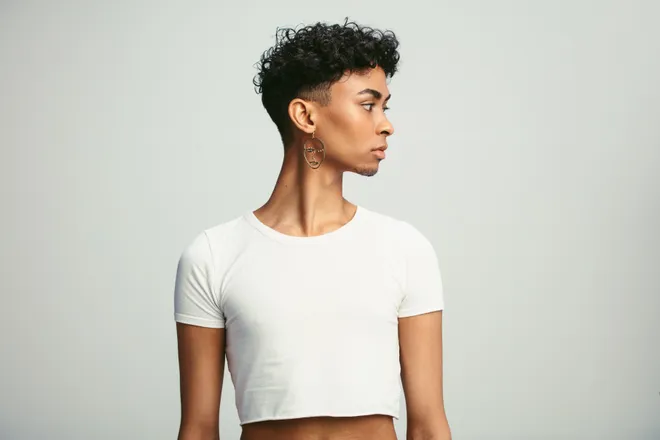Men are showing their stomachs in crop tops. Why some may shy away from the trend.
A hint of skin just above the waist. An exposed belly button. A full-on midriff. However you define it, the crop top for men is back.
Leave your preconceived notions about who can rock a crop top at the proverbial door; men of all different sexual orientations are experimenting with this trend.
But might this resurgence ignite feelings of body dysmorphia?
Experts say people shouldn't be afraid to express themselves through fashion, and that it's OK to step out of your comfort zone.

Men and crop tops
Fashion trends from the 1970s, '80s and '90s have been cycling through again – including the crop top. No one knows exactly when they cropped up (pun intended) in menswear, but experts like Joseph Hancock, professor of design at Drexel University, point to influences from the world of sports and entertainment.
Fashion historian Brian Centrone notes that college football athletes would crop their tops so there was nothing for their opponents to grab onto if they were being tackled and it became part of their aesthetic. "At the same time, though, there are people that say that gyms had started to forbid bare chests during workouts, and so bodybuilders would crop their tops to get around that," Centrone says.
Elsewhere, the disco era could have also influenced the gay community in New York and San Francisco, only for it to infiltrate the straight community as a manifestation of hypermasculinity. Think Will Smith in "The Fresh Prince of Bel-Air" to Prince to Mark Wahlberg in a Calvin Klein ad.
The crop top then disappeared, at least for straight men. In the '80s and '90s, society rejected many things queer given the rise of the HIV-AIDS crisis, likely pushing men away from even being perceived as gay. This coincided with the rise of grunge fashion in the '90s before the crop top's resurgence in the 2010s, and especially now with artists like Harry Styles, Troye Sivan and Lil Nas X adding their own spins.
Crop tops and body dysmorphia
Though the crop top has returned, like anything else fashion-wise, it's always slightly reimagined. It doesn't require a connection to sports anymore, for example. That said, you often see men with toned bodies flaunting their crop tops, which could create feelings of body dysmorphia.
Body dysmorphia is a mental health condition, according to the Mayo Clinic, in which you harp on perceived flaws in your appearance (and not to be confused with gender dysphoria).
"That can impact someone who was thinking about wearing a crop top. 'Am I toned enough? Is my body nice enough to show?'" says Denise H. Sutton, associate professor in the Department of Business at CUNY-City Tech.
While more body positivity exists today, men being targeted by fashion and beauty companies will still feel pressured to look "classically hot." But remember that you can wear them at varying lengths. If you're nervous about trying it on, consider: "How does the garment make you feel when you're wearing it?" Centrone says.
'We're all overcompensating':Why so many LGBTQ community members struggle with body dysmorphia
How to handle body dysmorphia
You can't police anyone else's behavior; but you can certainly thwart your social media algorithm's attempts to slam you with photo of crop top after crop top on toned bodies.
While choosing who to follow on social media, select accounts that show diverse body types. Unfollowing unhelpful body image types is also a good idea. Translation: Maybe stop following all those "fitspo" influencers.
Marla Deibler, licensed clinical psychologist, retrains clients on how they should look at themselves in the mirror as a form of therapy. "That teaches them to view themselves more holistically, and non-judgmentally while looking in the mirror, actually, rather than focusing on the perceived flaws that they have," she says. People can visit the Body Dysmorphic Disorder Foundation and the International OCD Foundation for more resources.
Even if these thoughts make up less than 15% of your time, they're still worth talking to someone about. It's also not something you need to solve overnight.
Plus, maybe you don't feel great about your body one day but decide to flex that crop top anyway. It's "practicing, even if it's anxiety-provoking, letting yourself wear the clothing that fits you, that is your size, and that makes you feel empowered," says eating disorder therapist Jennifer Rollin, "not trying to follow these traditional body standards that say, 'oh, only someone with a flat stomach can wear a crop top,' for instance."
If you or someone you know is struggling with body image or eating concerns, you can call The National Alliance for Eating Disorders' clinician-run helpline from 9 a.m. until 7 p.m. EST at (866) 662-1235. If you are in crisis or need immediate help, please text “ALLIANCE” to 741741 for free, 24/7 support.
In case you missed:Whitney Port, 'Barbie' and the truth about 'too thin'
Disclaimer: The copyright of this article belongs to the original author. Reposting this article is solely for the purpose of information dissemination and does not constitute any investment advice. If there is any infringement, please contact us immediately. We will make corrections or deletions as necessary. Thank you.






